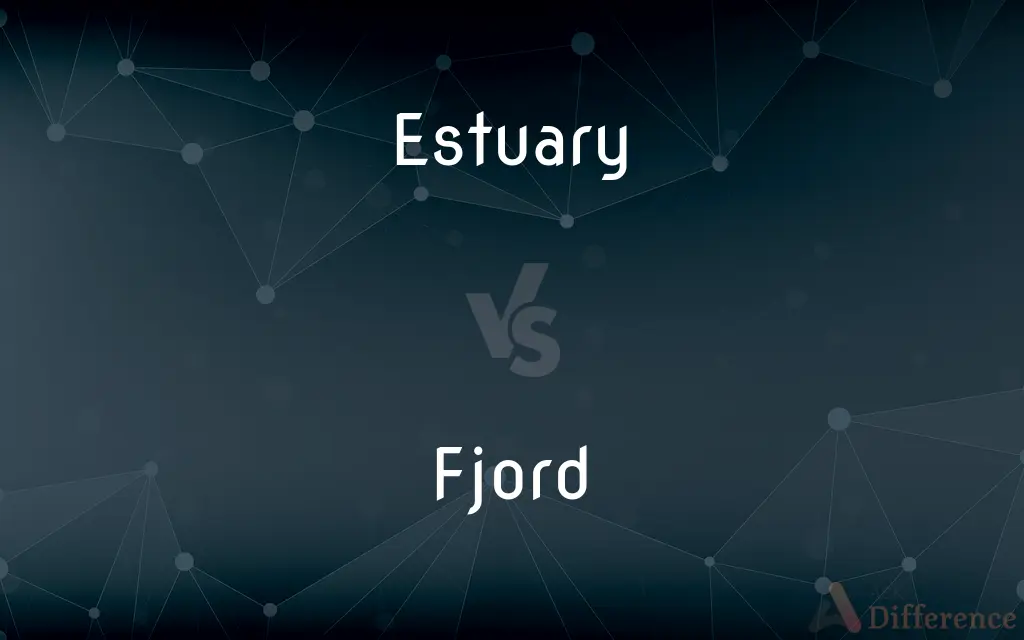Estuary vs. Fjord — What's the Difference?
Edited by Tayyaba Rehman — By Maham Liaqat — Updated on March 14, 2024
An estuary is a partially enclosed coastal body of water where freshwater from rivers mixes with seawater, fostering rich biodiversity. A fjord is a deep, narrow sea inlet, surrounded by steep cliffs or slopes, formed by glacier erosion.

Difference Between Estuary and Fjord
Table of Contents
ADVERTISEMENT
Key Differences
Estuaries are dynamic ecosystems located at the interface between rivers and the sea, characterized by the mixing of freshwater with saltwater. This unique combination supports a wide range of plant and animal life, making estuaries among the most productive natural habitats. Fjords, on the other hand, are long, narrow inlets with steep sides or cliffs, created by glacial activity. They are typically found in locations where current or past glaciation extended below current sea level.
The formation of estuaries is primarily due to the flooding of river valleys, leading to a semi-enclosed water body that has a free connection with the open sea. Fjords are formed by the deep carving of valleys by glaciers, followed by submersion under seawater after the glaciers retreat. This process results in fjords being much deeper than estuaries.
Estuaries often serve as critical habitats for fish, birds, and other wildlife, providing feeding, nesting, and breeding grounds. They play a vital role in the lifecycle of many marine species. Fjords, while also rich in biodiversity, are especially known for their dramatic landscapes and can support unique ecosystems both above and below the waterline.
In terms of human activity, estuaries are crucial for fisheries, and their flat expanses are often sites for ports and urban development due to their sheltered waters. Fjords, given their rugged terrain, are less suitable for urban development but are significant for tourism, recreational activities, and sometimes fisheries, depending on their location and ecological conditions.
Despite their differences, both estuaries and fjords are important water bodies that contribute significantly to their local ecosystems. Their protection and conservation are vital for maintaining biodiversity and supporting human economies.
ADVERTISEMENT
Comparison Chart
Definition
A partially enclosed coastal body where river freshwater meets and mixes with seawater.
A deep, narrow sea inlet with steep sides, created by glacial activity.
Formation
Flooding of river valleys.
Glacial carving and subsequent submersion under seawater.
Characteristics
Brackish water, high biodiversity, productive habitats.
Deep, narrow, with steep or cliff-like sides.
Biodiversity
Supports a wide range of species; nurseries for fish.
Unique ecosystems, supports varied marine and terrestrial life.
Human Use
Fisheries, ports, urban development.
Tourism, recreation, some fishing activities.
Compare with Definitions
Estuary
Characterized by varying salinity levels and supports diverse ecosystems.
Estuaries are teeming with life, from birds to fish and invertebrates.
Fjord
Features dramatic landscapes and unique biodiversity, both marine and terrestrial.
The fjords of New Zealand are renowned for their stunning beauty and ecological diversity.
Estuary
Often surrounded by wetlands, contributing to flood control and water purification.
The wetlands around estuaries act as natural water filters.
Fjord
A deep, glacially carved sea inlet surrounded by steep land on three sides.
Norway's Sognefjord extends over 200 kilometers inland from the coast.
Estuary
Important for human activities like fishing, shipping, and recreation.
Many major cities are located near estuaries due to their strategic and economic value.
Fjord
Formed by glacier movement and subsequent flooding by seawater.
Fjords were carved out by glaciers during the last Ice Age.
Estuary
A coastal area where freshwater from rivers mixes with seawater, creating a rich habitat.
The Chesapeake Bay is one of the largest estuaries in the United States.
Fjord
Can be very deep, with cold, nutrient-rich waters supporting marine life.
The deep waters of fjords often house diverse marine ecosystems.
Estuary
Vital for the lifecycle of many marine species, serving as breeding and feeding grounds.
Estuaries provide crucial nurseries for juvenile fish.
Fjord
Less suitable for urban development but popular for tourism and recreation.
The fjords in Scandinavia attract tourists from all over the world for their scenic views and outdoor activities.
Estuary
An estuary is a partially enclosed coastal body of brackish water with one or more rivers or streams flowing into it, and with a free connection to the open sea.Estuaries form a transition zone between river environments and maritime environments and are an example of an ecotone. Estuaries are subject both to marine influences such as tides, waves, and the influx of saline water and to riverine influences such as flows of freshwater and sediment.
Fjord
In geology, a fjord or fiord (alternatively fyord) ( (listen)) is a long, narrow inlet with steep sides or cliffs, created by a glacier. There are many fjords on the coasts of Alaska, Antarctica, British Columbia, Chile, Denmark, Greenland, the Faroe Islands, Iceland, Ireland, Kamchatka, the Kerguelen Islands, New Zealand, Norway, Novaya Zemlya, Labrador, Nunavut, Newfoundland, Quebec, Scotland, South Georgia Island, Isla de los Estados, and Washington state.
Estuary
The part of the wide lower course of a river where its current is met by the tides.
Fjord
A long, narrow, deep inlet of the sea between high cliffs, as in Norway, typically formed by submergence of a glaciated valley.
Estuary
An arm of the sea that extends inland to meet the mouth of a river.
Fjord
A long, narrow, deep inlet of the sea between steep slopes, especially one shaped by glacial action.
Estuary
A coastal water body where ocean tides and river water merge, resulting in a brackish water zone.
Fjord
A long, narrow, deep inlet between cliffs.
Estuary
An ocean inlet also fed by fresh river water.
Fjord
See Fiord.
Estuary
A place where water boils up; a spring that wells forth.
Fjord
A long narrow inlet of the sea between steep cliffs; common in Norway
Estuary
A passage, as the mouth of a river or lake, where the tide meets the current; an arm of the sea; a frith.
It to the sea was often by long and wide estuaries.
Estuary
Belonging to, or formed in, an estuary; as, estuary strata.
Estuary
The wide part of a river where it nears the sea; fresh and salt water mix
Common Curiosities
What causes the formation of fjords?
Fjords are formed by the carving action of glaciers, followed by the retreat of these glaciers and flooding of the valleys by seawater.
Are estuaries used for human activities?
Yes, estuaries are vital for fisheries, ports, and urban development due to their sheltered waters and strategic locations.
Why are estuaries important for marine life?
Estuaries serve as crucial nurseries for juvenile fish and other marine species, providing food, shelter, and breeding grounds.
How are estuaries formed?
Estuaries are formed by the flooding of river valleys, leading to the mixing of river freshwater with seawater.
Can fjords support diverse ecosystems?
Yes, fjords support unique ecosystems, offering habitats for various marine species and wildlife along their steep shores.
How do salinity levels vary in estuaries?
Salinity levels in estuaries vary widely, influenced by the mix of freshwater and seawater, creating diverse habitats.
What distinguishes an estuary from a fjord?
An estuary is a partially enclosed coastal body where freshwater mixes with seawater, rich in biodiversity, while a fjord is a deep, narrow sea inlet formed by glacial activity, known for its steep cliffs.
What makes fjords attractive for tourism?
The dramatic landscapes, outdoor recreational opportunities, and unique biodiversity of fjords make them popular tourist destinations.
What role do fjords play in the global ecosystem?
Fjords can act as significant carbon sinks and support diverse biological communities, contributing to the global ecosystem's health.
How do human activities impact estuaries and fjords?
Pollution, urban development, and climate change can threaten the delicate ecosystems of both estuaries and fjords, highlighting the need for conservation efforts.
Share Your Discovery

Previous Comparison
Layer vs. Sphere
Next Comparison
Spin vs. SwingAuthor Spotlight
Written by
Maham LiaqatEdited by
Tayyaba RehmanTayyaba Rehman is a distinguished writer, currently serving as a primary contributor to askdifference.com. As a researcher in semantics and etymology, Tayyaba's passion for the complexity of languages and their distinctions has found a perfect home on the platform. Tayyaba delves into the intricacies of language, distinguishing between commonly confused words and phrases, thereby providing clarity for readers worldwide.














































